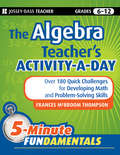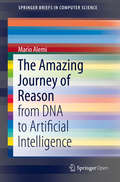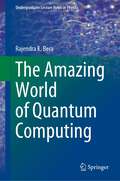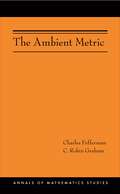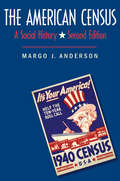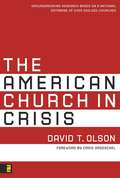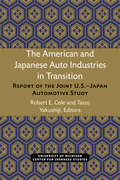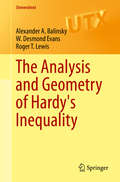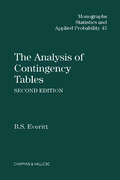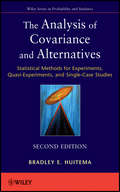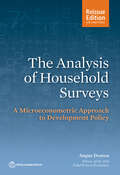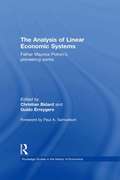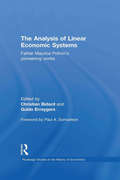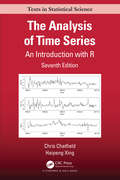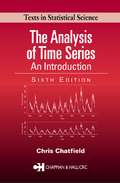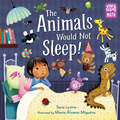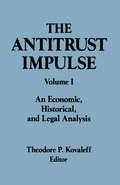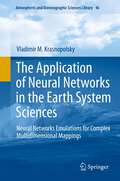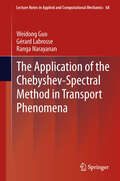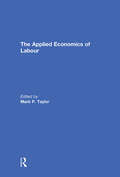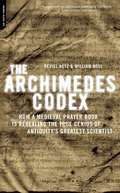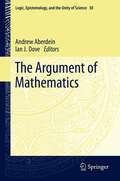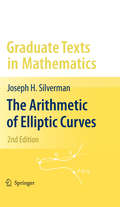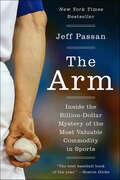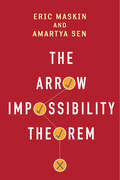- Table View
- List View
The Algebra Teacher's Activity-a-Day, Grades 6-12
by Frances McBroom Thompson Ed.D.Fun-filled math problems that put the emphasis on problem-solving strategies and reasoningThe Algebra Teacher's Activity-a-Day offers activities for test prep, warm-ups, down time, homework, or just for fun. These unique activities are correlated with national math education standards and emphasize problem-solving strategies and logical reasoning skills. In many of the activities, students are encouraged to communicate their different approaches to other students in the class.Filled with dozens of quick and fun algebra activities that can be used inside and outside the classroomDesigned to help students practice problem-solving and algebra skillsThe activities address a wide range of topics, skills, and ability levels, so teachers can choose whichever best suit the students' needs.
The Amazing Journey of Reason: from DNA to Artificial Intelligence (SpringerBriefs in Computer Science)
by Mario AlemiThis Open Access book explores questions such as why and how did the first biological cells appear? And then complex organisms, brains, societies and –now– connected human societies? Physicists have good models for describing the evolution of the universe since the Big Bang, but can we apply the same concepts to the evolution of aggregated matter –living matter included? The Amazing Journey analyzes the latest results in chemistry, biology, neuroscience, anthropology and sociology under the light of the evolution of intelligence, seen as the ability of processing information. The main strength of this book is using just two concepts used in physics –information and energy– to explain: The emergence and evolution of life: procaryotes, eukaryotes and complex organismsThe emergence and evolution of the brainThe emergence and evolution of societies (human and not)Possible evolution of our "internet society" and the role that Artificial Intelligence is playing
The Amazing World of Quantum Computing (Undergraduate Lecture Notes in Physics)
by Rajendra K. BeraThis book discusses the application of quantum mechanics to computing. It explains the fundamental concepts of quantum mechanics and then goes on to discuss various elements of mathematics required for quantum computing. Quantum cryptography, waves and Fourier analysis, measuring quantum systems, comparison to classical mechanics, quantum gates, and important algorithms in quantum computing are among the topics covered.The book offers a valuable resource for graduate and senior undergraduate students in STEM (science, technology, engineering, and mathematics) fields with an interest in designing quantum algorithms. Readers are expected to have a firm grasp of linear algebra and some familiarity with Fourier analysis.
The Ambient Metric (Annals of Mathematics Studies #178)
by Charles Fefferman C. Robin GrahamThis book develops and applies a theory of the ambient metric in conformal geometry. This is a Lorentz metric in n+2 dimensions that encodes a conformal class of metrics in n dimensions. The ambient metric has an alternate incarnation as the Poincaré metric, a metric in n+1 dimensions having the conformal manifold as its conformal infinity. In this realization, the construction has played a central role in the AdS/CFT correspondence in physics. The existence and uniqueness of the ambient metric at the formal power series level is treated in detail. This includes the derivation of the ambient obstruction tensor and an explicit analysis of the special cases of conformally flat and conformally Einstein spaces. Poincaré metrics are introduced and shown to be equivalent to the ambient formulation. Self-dual Poincaré metrics in four dimensions are considered as a special case, leading to a formal power series proof of LeBrun's collar neighborhood theorem proved originally using twistor methods. Conformal curvature tensors are introduced and their fundamental properties are established. A jet isomorphism theorem is established for conformal geometry, resulting in a representation of the space of jets of conformal structures at a point in terms of conformal curvature tensors. The book concludes with a construction and characterization of scalar conformal invariants in terms of ambient curvature, applying results in parabolic invariant theory.
The American Census
by Margo AndersonThis book, published on the eve of the bicentennial of the American census, is the first social history of this remarkably important institution, from its origins in 1790 to the present. Margo Anderson argues that the census has always been an influential policymaking tool, used not only to determine the number of representatives apportioned to each state but also to allocate tax dollars to states, and, in the past, to define groups-such as slaves and immigrants-who were to be excluded from the American polity.
The American Church in Crisis
by David T. OlsonDirector of church planting for the Evangelical Covenant Church, Minnesota-based Olson cites data reported by over 200,000 orthodox Christian churches to raise an alarm, though not in an alarmist manner, he says. On any given Sunday, he says, the vast majority of Americans are absent from church, and church attendance is not keeping up with the country's population growth. Chapter-end questions for reflection and discussion are included, but no index. Annotation ©2008 Book News, Inc. , Portland, OR (booknews. com)
The American and Japanese Auto Industries in Transition: Report of the Joint U.S.–Japan Automotive Study
by Robert E. Cole & Taizo YakushijiThis report was prepared for the Policy Board by the U.S. and Japanese research staffs of the Joint U.S.–Japan Automotive Study under the general direction of Professors Paul W. McCracken and Keichi Oshima, with research operations organized and coordinated by Robert E. Cole on the U.S. side, in close communication with the Taizo Yakushiji on the Japanese side. [preface] In view of the importance of stable, long-term economic relationships between Japan and the United States, automotive issues have to be dealt with in ways consistent with the joint prosperity of both countries. Furthermore, the current economic friction has the potential to adversely affect future political relationships. Indeed, under conditions of economic stagnation, major economic issues inevitably become political issues. With these considerations in mind, the Joint U.S.–Japan Automotive Study project was started in September 1981 to determine the conditions that will allow for the prosperous coexistence of the respective automobile industries. During this two-year study, we have identified four driving forces that will play a major role in determining the future course of the automotive industry of both countries. These are: (1) consumers’ demands and aspirations vis-à-vis automobiles; (2) flexible manufacturing systems (FMS); (3) rapidly evolving technology; and (4) the internationalization of the automotive industry. [exec. summary]
The Analysis and Geometry of Hardy's Inequality
by Alexander A. Balinsky W. Desmond Evans Roger T. LewisThis volume presents advances that have been made over recent decades in areas of research featuring Hardy's inequality and related topics. The inequality and its extensions and refinements are not only of intrinsic interest but are indispensable tools in many areas of mathematics and mathematical physics. Hardy inequalities on domains have a substantial role and this necessitates a detailed investigation of significant geometric properties of a domain and its boundary. Other topics covered in this volume are Hardy- Sobolev-Maz'ya inequalities; inequalities of Hardy-type involving magnetic fields; Hardy, Sobolev and Cwikel-Lieb-Rosenbljum inequalities for Pauli operators; the Rellich inequality. The Analysis and Geometry of Hardy's Inequality provides an up-to-date account of research in areas of contemporary interest and would be suitable for a graduate course in mathematics or physics. A good basic knowledge of real and complex analysis is a prerequisite.
The Analysis of Contingency Tables
by Brian S. EverittMuch of the data collected in medicine and the social sciences is categorical, for example, sex, marital status, blood group, whether a smoker or not and so on, rather than interval-scaled. Frequently the researcher collecting such data is interested in the relationships or associations between pairs, or between a set of such categorical variables;
The Analysis of Covariance and Alternatives
by Bradley E. HuitemaA complete guide to cutting-edge techniques and best practices for applying covariance analysis methods The Second Edition of Analysis of Covariance and Alternatives sheds new light on its topic, offering in-depth discussions of underlying assumptions, comprehensive interpretations of results, and comparisons of distinct approaches. The book has been extensively revised and updated to feature an in-depth review of prerequisites and the latest developments in the field. The author begins with a discussion of essential topics relating to experimental design and analysis, including analysis of variance, multiple regression, effect size measures and newly developed methods of communicating statistical results. Subsequent chapters feature newly added methods for the analysis of experiments with ordered treatments, including two parametric and nonparametric monotone analyses as well as approaches based on the robust general linear model and reversed ordinal logistic regression. Four groundbreaking chapters on single-case designs introduce powerful new analyses for simple and complex single-case experiments. This Second Edition also features coverage of advanced methods including: Simple and multiple analysis of covariance using both the Fisher approach and the general linear model approach Methods to manage assumption departures, including heterogeneous slopes, nonlinear functions, dichotomous dependent variables, and covariates affected by treatments Power analysis and the application of covariance analysis to randomized-block designs, two-factor designs, pre- and post-test designs, and multiple dependent variable designs Measurement error correction and propensity score methods developed for quasi-experiments, observational studies, and uncontrolled clinical trials Thoroughly updated to reflect the growing nature of the field, Analysis of Covariance and Alternatives is a suitable book for behavioral and medical scineces courses on design of experiments and regression and the upper-undergraduate and graduate levels. It also serves as an authoritative reference work for researchers and academics in the fields of medicine, clinical trials, epidemiology, public health, sociology, and engineering.
The Analysis of Household Surveys: A Microeconometric Approach to Development Policy (World Bank Ser.)
by Angus DeatonTwo decades after its original publication, The Analysis of Household Surveys is reissued with a new preface by its author, Sir Angus Deaton, recipient of the 2015 Nobel Prize in Economic Sciences. This classic work remains relevant to anyone with a serious interest in using household survey data to shed light on policy issues. The book reviews the analysis of household survey data, including the construction of household surveys, the econometric tools useful for such analysis, and a range of problems in development policy for which this survey analysis can be applied. Chapter 1 describes the features of survey design that need to be understood in order to undertake appropriate analysis. Chapter 2 discusses the general econometric and statistical issues that arise when using survey data for estimation and inference. Chapter 3 covers the use of survey data to measure welfare, poverty, and distribution. Chapter 4 focuses on the use of household budget data to explore patterns of household demand. Chapter 5 discusses price reform, its effects on equity and efficiency, and how to measure them. Chapter 6 addresses the role of household consumption and saving in economic development. The book includes an appendix providing code and programs using STATA, which can serve as a template for users' own analysis.
The Analysis of Linear Economic Systems: Father Maurice Potron’s Pioneering Works (Routledge Studies In The History Of Economics #117)
by Paul A. Samuelson Guido Erreygers Christian BidardMaurice Potron (1872-1942), a French Jesuit mathematician, constructed and analyzed a highly original, but virtually unknown economic model. This book presents translated versions of all his economic writings, preceded by a long introduction which sketches his life and environment based on extensive archival research and family documents. Potron had no education in economics and almost no contact with the economists of his time. His primary source of inspiration was the social doctrine of the Church, which had been updated at the end of the nineteenth century. Faced with the ‘economic evils’ of his time, he reacted by utilizing his talents as a mathematician and an engineer to invent and formalize a general disaggregated model in which production, employment, prices and wages are the main unknowns. He introduced four basic principles or normative conditions (‘sufficient production’, the ‘right to rest’, ‘justice in exchange’, and the ‘right to live’) to define satisfactory regimes of production and labour on the one hand, and of prices and wages on the other. He studied the conditions for the existence of these regimes, both on the quantity side and the value side, and he explored the way to implement them. This book makes it clear that Potron was the first author to develop a full input-output model, to use the Perron-Frobenius theorem in economics, to state a duality result, and to formulate the Hawkins-Simon condition. These are all techniques which now belong to the standard toolkit of economists. This book will be of interest to Economics postgraduate students and researchers, and will be essential reading for courses dealing with the history of mathematical economics in general, and linear production theory in particular. Paul A. Samuelson’s short foreword to the book may have been his last academic contribution.
The Analysis of Linear Economic Systems: Father Maurice Potron�s Pioneering Works (Routledge Studies In The History Of Economics #117)
by Paul A. Samuelson Guido Erreygers Christian BidardMaurice Potron (1872-1942), a French Jesuit mathematician, constructed and analyzed a highly original, but virtually unknown economic model. This book presents translated versions of all his economic writings, preceded by a long introduction which sketches his life and environment based on extensive archival research and family documents.Potron had no education in economics and almost no contact with the economists of his time. His primary source of inspiration was the social doctrine of the Church, which had been updated at the end of the nineteenth century. Faced with the ‘economic evils’ of his time, he reacted by utilizing his talents as a mathematician and an engineer to invent and formalize a general disaggregated model in which production, employment, prices and wages are the main unknowns. He introduced four basic principles or normative conditions (‘sufficient production’, the ‘right to rest’, ‘justice in exchange’, and the ‘right to live’) to define satisfactory regimes of production and labour on the one hand, and of prices and wages on the other. He studied the conditions for the existence of these regimes, both on the quantity side and the value side, and he explored the way to implement them.This book makes it clear that Potron was the first author to develop a full input-output model, to use the Perron-Frobenius theorem in economics, to state a duality result, and to formulate the Hawkins-Simon condition. These are all techniques which now belong to the standard toolkit of economists. This book will be of interest to Economics postgraduate students and researchers, and will be essential reading for courses dealing with the history of mathematical economics in general, and linear production theory in particular.
The Analysis of Time Series: An Introduction with R (Chapman & Hall/CRC Texts in Statistical Science)
by Chris Chatfield Haipeng XingThis new edition of this classic title, now in its seventh edition, presents a balanced and comprehensive introduction to the theory, implementation, and practice of time series analysis. The book covers a wide range of topics, including ARIMA models, forecasting methods, spectral analysis, linear systems, state-space models, the Kalman filters, nonlinear models, volatility models, and multivariate models.
The Analysis of Time Series: An Introduction, Sixth Edition
by Chris ChatfieldSince 1975, The Analysis of Time Series: An Introduction has introduced legions of statistics students and researchers to the theory and practice of time series analysis. With each successive edition, bestselling author Chris Chatfield has honed and refined his presentation, updated the material to reflect advances in the field, and presented inter
The Animals Would Not Sleep! (Storytelling Math #2)
by Sara LevineCelebrate diversity, math, and the power of storytelling!It's bedtime for Marco and his stuffed animals, but the animals have other ideas. When Marco tries to put them away, they fly, swim, and slither right out of their bins! Can Marco sort the animals so everyone is happy? A playful exploration of sorting and classifying that combines math with empathy. The perfect bedtime book, featuring Latinx characters and a note about scientific classification.Storytelling Math celebrates children using math in their daily adventures as they play, build, and discover the world around them. Joyful stories and hands-on activities make it easy for kids and their grown-ups to explore everyday math together. Developed in collaboration with math experts at STEM education nonprofit TERC, under a grant from the Heising-Simons Foundation.
The Antitrust Division of the Department of Justice: Complete Reports of the First 100 Years (Columbia University Seminar Ser. #Vol. 2)
by Theodore P. KovaleffAnalyzes the newly available statistical evidence on income distribution in the former Soviet Union both by social group and by republic, and considers the significance of inequalities as a factor contributing to the demise of the Communist regime.
The Application of Neural Networks in the Earth System Sciences
by Vladimir M. KrasnopolskyThis book brings together a representative set of Earth System Science (ESS) applications of the neural network (NN) technique. It examines a progression of atmospheric and oceanic problems, which, from the mathematical point of view, can be formulated as complex, multidimensional, and nonlinear mappings. It is shown that these problems can be solved utilizing a particular type of NN - the multilayer perceptron (MLP). This type of NN applications covers the majority of NN applications developed in ESSs such as meteorology, oceanography, atmospheric and oceanic satellite remote sensing, numerical weather prediction, and climate studies. The major properties of the mappings and MLP NNs are formulated and discussed. Also, the book presents basic background for each introduced application and provides an extensive set of references. "This is an excellent book to learn how to apply artificial neural network methods to earth system sciences. The author, Dr. Vladimir Krasnopolsky, is a universally recognized master in this field. With his vast knowledge and experience, he carefully guides the reader through a broad variety of problems found in the earth system sciences where neural network methods can be applied fruitfully. (...) The broad range of topics covered in this book ensures that researchers/graduate students from many fields (...) will find it an invaluable guide to neural network methods." (Prof. William W. Hsieh, University of British Columbia, Vancouver, Canada) "Vladimir Krasnopolsky has been the "founding father" of applying computation intelligence methods to environmental science; (...) Dr. Krasnopolsky has created a masterful exposition of a young, yet maturing field that promises to advance a deeper understanding of best modeling practices in environmental science." (Dr. Sue Ellen Haupt, National Center for Atmospheric Research, Boulder, USA) "Vladimir Krasnopolsky has written an important and wonderful book on applications of neural networks to replace complex and expensive computational algorithms within Earth System Science models. He is uniquely qualified to write this book, since he has been a true pioneer with regard to many of these applications. (...) Many other examples of creative emulations will inspire not just readers interested in the Earth Sciences, but any other modeling practitioner (...) to address both theoretical and practical complex problems that may (or will!) arise in a complex system." " (Prof. Eugenia Kalnay, University of Maryland, USA)
The Application of the Chebyshev-Spectral Method in Transport Phenomena
by Ranga Narayanan Gérard Labrosse Weidong GuoTransport phenomena problems that occur in engineering and physics are often multi-dimensional and multi-phase in character. When taking recourse to numerical methods the spectral method is particularly useful and efficient. The book is meant principally to train students and non-specialists to use the spectral method for solving problems that model fluid flow in closed geometries with heat or mass transfer. To this aim the reader should bring a working knowledge of fluid mechanics and heat transfer and should be readily conversant with simple concepts of linear algebra including spectral decomposition of matrices as well as solvability conditions for inhomogeneous problems. The book is neither meant to supply a ready-to-use program that is all-purpose nor to go through all manners of mathematical proofs. The focus in this tutorial is on the use of the spectral methods for space discretization, because this is where most of the difficulty lies. While time dependent problems are also of great interest, time marching procedures are dealt with by briefly introducing and providing a simple, direct, and efficient method. Many examples are provided in the text as well as numerous exercises for each chapter. Several of the examples are attended by subtle points which the reader will face while working them out. Some of these points are deliberated upon in endnotes to the various chapters, others are touched upon in the book itself.
The Applied Economics of Labour
by Mark P. TaylorThis book provides an introduction and overview to seven applied financial studies on the theme of labour. The studies cover a wide range of topics, from the individual effects of becoming disabled on key aspects of labour market outcomes in Germany, to testing whether there is evidence of compression of morbidity using Health and Retirement Study (HRS) data and analysing the effects of this on the labour supply of older people. The studies employ a variety of applied techniques across a range of countries. This book was originally published as a special issue of Applied Economics.
The Archimedes Codex: How a Medieval Prayer Book Is Revealing the True Genius of Antiquity's Greatest Scientist
by Reviel NetzPart archaeological detective story, part science, and part history, The Archimedes Codex tells the astonishing story of a lost manuscript, from its tenth-century creation in ancient Constantinople to the auction block at Christie’s in New York, and how a team of scholars used the latest imaging technology to reveal and decipher the original text. What they found was the earliest surviving manuscript by Archimedes (287 BC#150;212 BC), the greatest mathematician of antiquity#151;a manuscript that established, for the first time, the extent of his mathematical genius, which was two thousand years ahead of modern science.
The Argument of Mathematics
by Andrew Aberdein Ian J DoveWritten by experts in the field, this volume presents a comprehensive investigation into the relationship between argumentation theory and the philosophy of mathematical practice. Argumentation theory studies reasoning and argument, and especially those aspects not addressed, or not addressed well, by formal deduction. The philosophy of mathematical practice diverges from mainstream philosophy of mathematics in the emphasis it places on what the majority of working mathematicians actually do, rather than on mathematical foundations. The book begins by first challenging the assumption that there is no role for informal logic in mathematics. Next, it details the usefulness of argumentation theory in the understanding of mathematical practice, offering an impressively diverse set of examples, covering the history of mathematics, mathematics education and, perhaps surprisingly, formal proof verification. From there, the book demonstrates that mathematics also offers a valuable testbed for argumentation theory. Coverage concludes by defending attention to mathematical argumentation as the basis for new perspectives on the philosophy of mathematics.
The Arithmetic of Elliptic Curves
by Joseph H. SilvermanThe theory of elliptic curves is distinguished by its long history and by the diversity of the methods that have been used in its study. This book treats the arithmetic approach in its modern formulation, through the use of basic algebraic number theory and algebraic geometry. Following a brief discussion of the necessary algebro-geometric results, the book proceeds with an exposition of the geometry and the formal group of elliptic curves, elliptic curves over finite fields, the complex numbers, local fields, and global fields. Final chapters deal with integral and rational points, including Siegels theorem and explicit computations for the curve Y = X + DX, while three appendices conclude the whole: Elliptic Curves in Characteristics 2 and 3, Group Cohomology, and an overview of more advanced topics.
The Arm: Inside the Billion-Dollar Mystery of the Most Valuable Commodity in Sports
by Jeff PassanYahoo’s lead baseball columnist offers an in-depth look at the most valuable commodity in sports—the pitching arm—and how its vulnerability to injury is hurting players and the game, from Little League to the majors.Every year, Major League Baseball spends more than $1.5 billion on pitchers—five times more than the salary of every NFL quarterback combined. Pitchers are the game’s lifeblood. Their import is exceeded only by their fragility. One tiny band of tissue in the elbow, the ulnar collateral ligament, is snapping at unprecedented rates, leaving current big league players vulnerable and the coming generation of baseball-playing children dreading the three scariest words in the sport: Tommy John surgery.Jeff Passan traveled the world for three years to explore in-depth the past, present, and future of the arm, and how its evolution left baseball struggling to wrangle its Tommy John surgery epidemic. He examined what compelled the Chicago Cubs to spend $155 million on one arm. He snagged a rare interview with Sandy Koufax, whose career was cut short by injury at thirty, and visited Japan to understand how another baseball-mad country treats its prized arms. And he followed two major league pitchers, Daniel Hudson and Todd Coffey, throughout their returns from Tommy John surgery. He exposes how the baseball establishment long ignored the rise in arm injuries and reveals how misplaced incentives across the sport stifle potential changes.Injuries to the UCL start as early as Little League. Without a drastic cultural shift, baseball will continue to lose hundreds of millions of dollars annually to damaged pitchers, and another generation of children will suffer the same problems that vex current players. Informative and hard-hitting, The Arm is essential reading for everyone who loves the game, wants to keep their children healthy, or relishes a look into how a large, complex institution can fail so spectacularly.
The Arrow Impossibility Theorem
by Amartya Sen Joseph E. Stiglitz Kenneth J. Arrow Eric Maskin Prasanta K. PattanaikKenneth Arrow's pathbreaking "impossibility theorem" was a watershed in the history of welfare economics, voting theory, and collective choice, demonstrating that there is no voting rule that satisfies the four desirable axioms of decisiveness, consensus, nondictatorship, and independence. In this book, Amartya Sen and Eric Maskin explore the implications of Arrow's theorem. Sen considers its ongoing utility, exploring the theorem's value and limitations in relation to recent research on social reasoning, while Maskin discusses how to design a voting rule that gets us closer to the ideal -- given that achieving the ideal is impossible. The volume also contains a contextual introduction by social choice scholar Prasanta K. Pattanaik and commentaries from Joseph E. Stiglitz and Kenneth Arrow himself, as well as essays by Sen and Maskin outlining the mathematical proof and framework behind their assertions.
